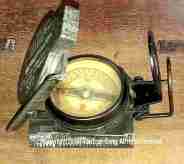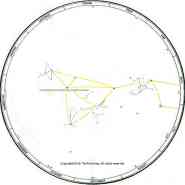Finding North Direction and Time using Geological Features, plants and animals
by tonytran2015 (Melbourne, Australia).
Click here for a full, up to date ORIGINAL ARTICLE and to help fighting the stealing of readers’ traffic.
(Blog No.70).
#find North, #time, #wind, #cloud, #tree, #find North by moss #moss, #bird, #roosting, #gecko, #chameleon, #croaking.
Finding North Direction and Time by Geological Features, plants and animals.
There are many different ways to find North direction and time [1-9], the following methods are currently less known but have been very popular in the past.
1. Geological formation.
For example, if there is a distant mountain range on the West (example only) or a seashore on the East (example only) then any of them can be used a directional pointer.
A river, a road, a railway line in view can also be used as a direction pointer.
The side of a nearby hill with more plant life is also the side illuminated by the morning Sun.
2. Winds.
A large geological formation such as a distant mountain range can create a year round daily winds of constant directions that can be used as directional indicators.
The smell of a wind (salty smell, plant smell) can also reveal where it comes from (the sea, a forrest with a particular smell) and consequently its direction.
Even the sounds in the wind can also reveal where it comes from and consequently its direction.
3. Permanent Cloud Formation.
Permanent Cloud Formation on top of geological features can tell earth dwellers their positions and directions. This method is used by islanders in the oceans.
4. The Growth of Trees and Mosses.
Trees and moss use sunlight to photo-synthesize their nutrients and body building substances. Their parts grow best with water, sunlight and warmth, We can use tree features to tell directions: The sunny half of the trees has thicker veins, grains to support more leaves synthesizing nutrients. Trees bear more flowers and fruits on their sides lit by the morning Sun.
However, caution should be exercised as a permanent strong wind blowing the same way for the whole year may affect the growth of trees.
5. The Growth of Mosses.
Figure: Moss growth on West side of tree trunc.
Figure: East side of the same tree trunc.
Mosses use sunlight to photo-synthesize their nutrients and body building substances. Mosses and trees have evolved to have different diurnal cycles and their photo-syntheses are efficient at different times: Trees prefer and grow best in morning sunlight while mosses afternoon sunlight.
Mosses need both Dampness and some right amount of Afternoon Sunlight (Photo-Synthesis by mosses is better in the afternoon). Therefore they grow on a damp tree trunc on the side that CAN RECEIVE AFTERNOON SUNLIGHT. (However, too much afternoon SUNLIGHT CAN DRY OUT DAMPNESS and KILL THE MOSS !) The difference between Eastern and Western growth of mossses is usually not profound but can be noticed. This can be seen from the above pictures. In these figures taken in Southern hemisphere, moss grows on the South West side.
Moss growth is also affected by prevailing winds which dry out tree truncs unevenly. Finding directions by Mosses should only be practiced as a last resort when all Celestial and compass methods cannot be applied and when there is certainly no permanent prevailing wind drying out the trunc unevenly.
4. Foraging by Birds
Birds want to have longer foraging time and warmth. That is why some types of birds even do yearly migration to the other terrestrial hemisphere.
At the first sight of sunlight in the morning, birds fly up and toward the Sun (eastwards or almost eastwards) . They forage in the fields there, eating young shoots that grew overnight, then fly home when they have been fully fed. Birds come back to their nests, checking them for unwanted invaders, do their droppings then sleep well before sunset time. (Only few nocturnal types of birds have good night vision).
5. Nesting by Birds
Birds build their nests on the warm side of a foliage.
In temperate zones, their nests point away from the poles. Bird dropping reveals the locations of bird nests relative to the host tree.
6. Man made dwellings.
Free standing country houses are usually oriented to receive maximum morning sunlight.
7. Birds Tweetting and Chickens Roosting.
Birds tweeting and chicken roosting have been used as reliable time markers in the past, before watches are popularly available. They mean the birds have seen first glimpse of sunlight.
Country people in Vietnam used to start their days on the roosting of chickens at the first sight of a brightened horizon before dawn.
8. Geckos and chameleons croaking.
Geckos and chameleons see best and croak at noon in tropical countries. Their croaking is a fairly accurate noon signal (with 30 minutes accuracy).
References.
[1]. tonytran2015, Using GPS in off-grid situations., https://survivaltricks.wordpress.com/2016/12/06/using-gps-in-off-grid-situations/, posted December 6, 2016
[2]. tonytran2015, Selecting and using magnetic compasses, survivaltricks.wordpress.com, https://survivaltricks.wordpress.com/2016/07/09/selecting-and-using-magnetic-compasses/, posted 09/7/2016.
[3]. tonytran2015, Finding North direction and time by stars, survivaltricks.wordpress.com, https://survivaltricks.wordpress.com/2015/08/28/finding-north-and-time-by-stars/ , posted on August 28, 2015.
[4]. tonytran2015, Finding North and time by stars in the tropics, survivaltricks.wordpress.com, https://survivaltricks.wordpress.com/2016/05/25/finding-north-and-time-by-stars-in-the-tropics/, posted on May 25, 2016
[5]. tonytran2015, Using polarized light to locate the Sun when it is hidden from view, https://survivaltricks.wordpress.com/2015/05/09/using-polarized-light-to-locate-the-sun-hidden-behind-clouds/, posted on May 9, 2015
[6]. tonytran2015, Finding accurate directions using a watch, survivaltricks.wordpress.com, https://survivaltricks.wordpress.com/2015/05/19/finding-accurate-directions-using-a-watch/, posted May 19, 2015
[7]. tonytran2015, Finding directions and time using the Sun and a divider, survivaltricks.wordpress.com, https://survivaltricks.wordpress.com/2015/05/06/finding-directions-and-time-using-the-sun-and-a-dividing-compass/, posted on May 6, 2015.
[8]. Shadow stick navigation and graph of solar paths, posted August 19, 2016
[9]. Navigating with an AM MW radio receiver.
Added after 2018 April 25:
[10]. https://nannatrips.com/2017/10/16/magnetic-termites-of-australia/
Relevant  SURVIVAL blogs:
SURVIVAL blogs:
Finding accurate directions using a watch, posted on May 19, 2015

Finding North direction and time using the hidden Sun via the Moon . Posted on July 6, 2015

Finding-north-by-stars-for-beginners, posted on September 20, 2017
Finding North and time by stars. Posted on August 28, 2015

Finding North and time with unclear sky. Posted on October 17, 2015.
Finding North with a lensatic compass, posted on August 21, 2017

Good approximation to solar declination by a watch face , Navigating with an AM MW radio receiver, The Scorpius constellation, Quick fire making using sunlight.,The Orion constellation, Rice as emergency food , Using GPS in off-grid situations, Identifying moderately bright navigational stars, Slide Sky-Map for displaying tropical stars,…all.
Click here for my other blogs.
SURVIVAL BLOG ![]() SURVIVAL CONTENTS BLOG IMAGE OF SURVIVAL CONTENTS
SURVIVAL CONTENTS BLOG IMAGE OF SURVIVAL CONTENTS
MONEY BLOG ![]() MONEY CONTENTS BLOG IMAGE OF MONEY CONTENTS
MONEY CONTENTS BLOG IMAGE OF MONEY CONTENTS
SOCIAL ISSUES BLOG SOCIAL ISSUES CONTENTS BLOG IMAGE OF CONT. OF SOCIAL ISSUES
LIVING BLOG LIVING CONTENTS BLOG IMAGE OF LIVING CONTENTS
HOW TO BLOG HOW TO CONTENTS BLOG IMAGE OF HOW TO CONTENTS
Click here for all my blogs
ARCHIVAL HOME PAGE CONTENTS HOME PAGE BLOG IMAGE OF CONTENTS HOME PAGE
SUBSCRIPTION: [RSS – Posts], [RSS – Comments]
MENU: [Contents][Blog Image of Contents ][Archives ] [About]





Reblogged this on disturbeddeputy.
LikeLike
Thank you, disturbeddeputy, for re-blogging.
LikeLike
Reblogged this on The way I see things ….
LikeLike
Thank you, Lisa the Infidel, for re-blogging
LikeLike
[…] Source: Finding North Direction and Time using Geological Features, plants and animals […]
LikeLiked by 1 person
Thank you, ST, for the link.
LikeLike
Reblogged this on .
LikeLike
Thank you, Brittius, for re-blogging.
LikeLike
You’re welcome.
LikeLiked by 1 person